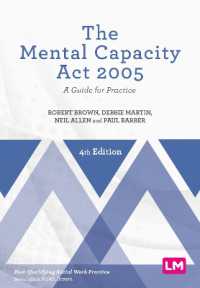Full Description
This volume of case studies focuses on the geographies of COVID-19 around the world. These geographies are located in both time and space concentrating on both first- and second-order impacts of the COVID-19 pandemic. First-order impacts are those associated with the immediate response to the pandemic that include tracking number of deaths and cases, testing, access to hospitals, impacts on essential workers, searching for the origins of the virus and preventive treatments such as vaccines and contact tracing. Second-order impacts are the result of actions, practices, and policies in response to the spread of the virus, with longer-term effects on food security, access to health services, loss of livelihoods, evictions, and migration. Further, the COVID-19 pandemic will be prolonged due to the onset of variants as well as setting the stage for similar future events. This volume provides a synopsis of how geography and geospatial approaches are used to understand this event andthe emerging "new normal." The volume's approach is necessarily selective due to the global reach of the pandemic and the broad sweep of second-order impacts where important issues may be left out. However, the book is envisioned as the prelude to an extended conversation about adaptation to complex circumstances using geospatial tools.
Using case studies and examples of geospatial analyses, this volume adopts a geographic lens to highlight the differences and commonalities across space and time where fundamental inequities are exposed, the governmental response is varied, and outcomes remain uncertain. This moment of global collective experience starkly reveals how inequality is ubiquitous and vulnerable populations - those unable to access basic needs - are increasing. This place-based approach identifies how geospatial analyses and resulting maps depict the pandemic as it ebbs and flows across the globe. Data-driven decision making is needed as we navigate the pandemic and determine ways to address future such events to enable local and regional governments in prioritizing limited resources to mitigate the long-term consequences of COVID-19.
Contents
Chapter 1. How covid changed our daily geographies.- Chapter 2. Geography of the pandemic.- Chapter 3. Defining first- and second-order impacts through maps.- Chapter 4. Quantitative geographical approaches in COVID-19 research: A review on first- and second-order impacts.- Chapter 5. COVID-19's impact on geospatial data: ethics and values.- Chapter 6. The City and the Pandemic - the Cities' COVID Mitigation Mapping (C2M2) Program .- Chapter 7. Improving access to health services in Mongolia via open data during and beyond the COVID-19 pandemic.- Chapter 8. The inequities in the U.S. during the COVID-19 pandemic.- Chapter 9. The Latine community and COVID-19: nuances, experiences, and data.- Chapter 10. An overview of the impact of COVID-19 in Nepal's international tourism industry.- Chapter 11. Data and dashboards for measuring the social impact of COVID-19 in African cities.- Chapter 12. COVID-19 and domestic violence complaints in Quito, Ecuador: temporal and spatial patterns anddrivers.- Chapter 13. Mapping COVID-19: Should it be based on the incidence rate? A case study in China.- Chapter 14. Regional patterns of the pandemic: a view from Aotearoa New Zealand.- Chapter 15. Aboriginal and Torres Strait Islander peoples & the COVID-19 pandemic: a spatial and place-based analysis.- Chapter 16. Impacts of COVID-19 pandemic lockdown on the livelihoods of male commercial Boda-Boda motorists in Uganda.- Chapter 17. Geospatial techniques for mapping the spatial trajectories of COVID-19.- Chapter 18. Digital geographies and digital surveillance technologies: power and space in the Italian society under control for public health.- Chapter 19. Resilience amid uncertainty: COVID-19 pandemic, the urban informal sector, and livelihoods in sub-Saharan Africa.- Chapter 20. Freshwater Resources and COVID-19.- Chapter 21. Preventing pandemics: earth observations for One Health.- Chapter 22. Enabling Accelerated Research in Times of Need: The National Science Foundation's Response to COVID-19 in 2020.- Chapter 23. Conclusion - The consequences of COVID-19 - What's next?.








